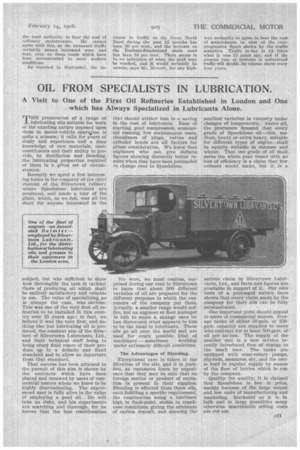A . County Engineer on Road Problems.
Page 52

Page 53

If you've noticed an error in this article please click here to report it so we can fix it.
IN the course of a report on road expenditure, Mr. W. J. Merrett, county engineer of Durham, refers to the increased burden of road costs on the local rates. A factor which has affected expenditure on main roads and county bridges since the war has been the high cost of materials and labour, as compared with pre-war prices. The gross expenditure on the county main roads and bridges has, since 1908, increased between 600 per cent. and 700 per cent.
Team labour, which was 8s, a day in 1908, is now 14s. In the peak year, 1922, the figure was a straight 200 per cent increase on the pre-war prices, but taking the average over the years since the war, the increase over the prewar years amounts to 119 per cent. The rail-freight charges on road materials rose to 75 per cent, over prewar rates and are now 60 per cent, over the base rates of 1914.
Factors Responsible for Higher Maintenance Costs.
In 1914 roadmen's wages averaged 11 6s. a week. This average rate, at its highest point after the war, reached 13 13s. 4d. per week, an increase of 182 per cent„ but for the last three years the average weekly wage has been 12 9s., which is an increase of 88 per cent. over the pre-war figure.
From the above details it can readily be seen that the increased cost of road maintenance under these -heads has only been a comparatively small factor in the 600 per cent to 700 per cent increase in gross costs.
Both the heavy goods vehicle and the motorbirs are at present undertaking longer journeys and working in a much larger area from their centres. To c30
support his contention as to the development of the motorbus traffic, Mr. Merrett gives details of services running from Newcastle to London, Leeds, Glasgow, Blackpool, Scarborough and Liverpool. Furthermore, there has been a considerable number of longdistance tours, which have, in many instances, amounted to daily services.
The Growth of Goods Transport by Road.
Dealing with the carrying of goods on the roads, from observations made on the main highways in the county during the past few months it has been ascertained that lorries are regularly carrying goods from South Yorkshire and Lancashire to the Tyne, and vice versa. On numerous occasions lorries have also been observed which have been carrying goods from London and the Midlands, and it would appear that many manufacturing firms in the South now distribute their goods to the North of England and Scotland by their oWn lorries.
On the main roads in Durham the total amount of traffic to-day is over 94 times that of 1913. The statistics with regard to the district roads show that since the war traffic has increased about four to five times, and, in some cases, to an even greater extent The ' expenditure—in the 26 districts included—on highway administration has increased over the period from 1908 to 1926 from 174,462 to 1439,251. The net expenditure from district rates has increased from £68,808 to £304,582.
There was need, says Mr. Merrett, for additional assistance, apart from special grants from the Road Fund through the Ministry of Transport. The Ministry, in the past, recognized that
incertain circumstances an additional grant, other than the 50 per cent. and 25 per cent., was necessary if -the highway authority was to adapt a road to modern traffic conditions, and, therefore, instituted what were known as "trunk-road schemes," where grants ranging from 75 per cent, to, in some cases, 100 per cent. were given. Further, with regard to the rural roads the Ministry gave special grants, under certain conditions amounting to 75 per cent, of the cost, to rural district councils which reconstructed a road with a view to the same being declared a main road by the county council. These, however, should be looked upon as special grants, but the Ministry has now issued a circular increasing their ordinary maintenance grants on secOndclass roads from 25 per cent. to 33 per cent., and on selected unclassified roads from 20 per cent. to 25 per cent.
A Suggestion—Stabilize the Highway Authority's Local Rate.
The county engineer of Durham does not suggest any specific percentage grants from the Ministry of Transport. The suggestion he puts forward is to the effect that the highway authority's local rate should be stabilized for a certain period and that all other moneys necessary for the maintenance, repair and improvement of the highways, together with the costs of any new highways or bridges constructed, should be borne by the National Road Fund.
It might be contended that the increase in traffic is responsible only for the demand for reconstructed and adapted roads and the construction of new roads, and that his contentions would be met by the Road Fund meeting the cost of all new works, leaving the read authority to bear the cost of ordinary maintenance. He cannot agree with this, as the increased traffic certainly means increased wear and tear, even on those roads which have been reconstructed to meet modern conditions.
As reported in September, the in
crease in traffic on the Great North Road during the past 12 months has been 30 per cent., and the increase on the Durham-Sunderland main road has been 111 per cent.. There seems to be no indication of when the peak may be reached, and it would certainly be unwise, says Mr. Merrett, for any high way authority to agree to bear the cost of maintenance in view of the everprogressive figure shown by the traffic statistics. Traffic to-day is 14 times what it was 15 years ago, and if the Present rate of increase is maintained traffic will double its volume about every four years.












































































































